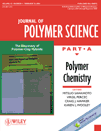Synthesis and structural characterization of novel, fluorinated poly(phthalazinone ether)s containing perfluorophenylene moieties
Abstract
The synthesis and structural characterization of a series of novel, fluorinated poly(phthalazinone ether)s containing perfluorophenylene moieties are described. The monomers, 4-(4′-hydroxyaryl)phthalazin-1(2H)-ones (2a–2d), were conveniently and efficiently synthesized from phenols and phthalic anhydride in two steps via 2-(4′-hydroxybenzoyl)benzoic acids, which were first obtained by the Friedel–Crafts reaction in good yields and with high stereoselectivity and were then converted into 2a–2d by fusion with hydrazine. All the polymers were prepared by nucleophilic aromatic substitution (SNAr) polycondensation between the compounds perfluorobiphenyl and 4-(4′-hydroxyaryl)phthalazin-1(2H)-ones (2a-2d). The resulting fluorinated polymers were readily soluble in common organic solvents (e.g., CHCl3, tetrahydrofuran, dimethylformamide, dimethyl sulfoxide, N-methylpyrrolidone, etc.) at room temperature. Their weight-average molecular weights and the polydispersities ranged from (7.96–18.25) × 103 to 1.31–2.71, respectively. Their glass-transition temperatures varied from 213 to 263 °C. They were all stable up to 390 °C both in air and in argon. The 5% weight-loss temperatures of these polymers in air and argon ranged from 393–487 to 437–509 °C, respectively. Wide-angle X-ray diffraction studies indicated they were all amorphous and could be attributed to the presence of kink nonplanar moiety, phenyl phthalazinone along the polymer backbone. © 2004 Wiley Periodicals, Inc. J Polym Sci Part A: Polym Chem 42: 925–932, 2004




